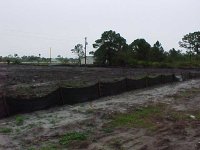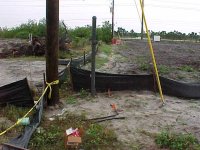It is part of the building code in most municipalities. I think it might be in the model codes they all adopt.
In my city, bujilding our house, the first inspection of the foundation excavation also included inspection of all the silt fences. No silt fences, no passing the foundation inspection and no proceeding with the project.
The building permit included a deposit that would be forfeit if among other conditions, proper runoff control (silt fences, etc) were not kept in place during the project.
Also, the state has some pretty stiff fines for uncontrolled runoff from a construction site into a lake, river, or stream.
They do work. Down by the lake after a big storm, the silt fence was over-flowing. It was about 18" to 24" high. The stakes barely held the water.
Later when the water drained down, I discovered that there was about 18" of silt that had collected behind the whole area of the fence. It took half a day of digging with my little 4100 to "empty" the silt fence just in time for it to start raining again.
The contractors who knew about silt fences because they have to deal with putting them up and maintaining them themselves were careful not to destroy the fences. Those who didn't know or care, seemed to delight in running over it with trucks, cranes, and Bobcats.
Installation is manual-labor intensive. The fence is required to be anchored into the ground in a slit or have the bottom covered with enough dirt so as not to let water under-flow it or otherwise leak. The stakes have to be big enough to hold the weight of the water flow back.
For long fencing runs, there is a 3-point attachment that will slit the ground and install the material from a big roll. The fancier attachments can even pound in the stakes for you they goes. Could be a nice business opportunity for somebody with a CUT and one of those attachments going around on bigger construction sites.
- Rick
In my city, bujilding our house, the first inspection of the foundation excavation also included inspection of all the silt fences. No silt fences, no passing the foundation inspection and no proceeding with the project.
The building permit included a deposit that would be forfeit if among other conditions, proper runoff control (silt fences, etc) were not kept in place during the project.
Also, the state has some pretty stiff fines for uncontrolled runoff from a construction site into a lake, river, or stream.
They do work. Down by the lake after a big storm, the silt fence was over-flowing. It was about 18" to 24" high. The stakes barely held the water.
Later when the water drained down, I discovered that there was about 18" of silt that had collected behind the whole area of the fence. It took half a day of digging with my little 4100 to "empty" the silt fence just in time for it to start raining again.
The contractors who knew about silt fences because they have to deal with putting them up and maintaining them themselves were careful not to destroy the fences. Those who didn't know or care, seemed to delight in running over it with trucks, cranes, and Bobcats.
Installation is manual-labor intensive. The fence is required to be anchored into the ground in a slit or have the bottom covered with enough dirt so as not to let water under-flow it or otherwise leak. The stakes have to be big enough to hold the weight of the water flow back.
For long fencing runs, there is a 3-point attachment that will slit the ground and install the material from a big roll. The fancier attachments can even pound in the stakes for you they goes. Could be a nice business opportunity for somebody with a CUT and one of those attachments going around on bigger construction sites.
- Rick




